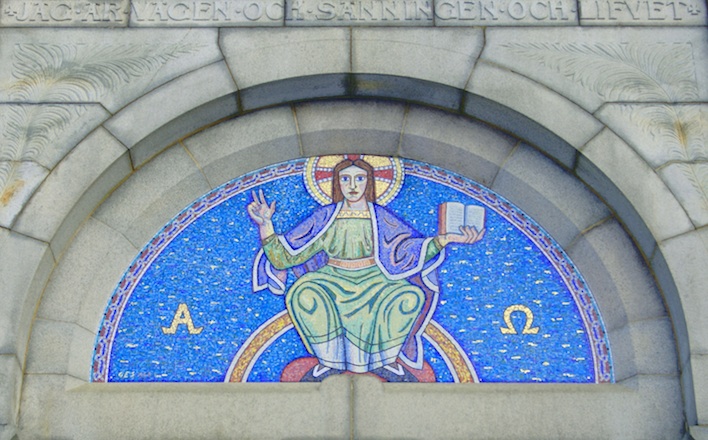Commentary on John 14:1-14
This Sunday is the first of two Sundays from the 14th chapter of John.
Chapters 13-17 are best known as the Farewell Discourse in the Fourth Gospel. Chapter 13 narrated the footwashing, the last meal shared between Jesus and his disciples, and the departure of Judas to the dark side (13:30). Chapter 14 picks up with direct words from Jesus to his disciples about his impending departure. They are words of comfort and hope, promise and plain speech, and little mincing of words as to what’s soon to take place.
It should seem just a little odd, or feel like an itching burr under our liturgical saddles, that a chapter in which Jesus offers his formal good-byes to the disciples is heard in the Sundays after Easter, when he is, well, for lack of a better term, back. Taking the literary context seriously when interpreting this text, however, gets at a critical theological claim for the Fourth Gospel, and particularly, what resurrection means for the Fourth Evangelist.
To be clear, I am not suggesting a sermon on reading the mind of the author of the Fourth Gospel and then telling your congregation his (probably his) interpretation of the resurrection. I am proposing, however, that the specificity with which this text speaks to the function and meaning of resurrection might frame how we imagine the promise of the resurrection beyond the seventh Sunday of Easter.
A brief Johannine theological summary: Jesus’ farewell words to his disciples in this discourse anticipate and assume the events that lie ahead: the crucifixion, the resurrection, and the ascension. Each one of these realities is the result of the primary theological event in the Gospel of John, the incarnation. The disciples are going to be faced with the end of the incarnation, the end of Jesus’ presence on earth as God. Jesus needs them to know that there is more beyond the crucifixion which, for John, is the inevitable outcome of being human. That which becomes human must die.
At the same time, the resurrection and then the ascension are the next realities in store, for Jesus and for his believers. Note that even the resurrection is not the end all. The resurrection presumes that there is something even beyond itself, the ascension. The beginning of chapter 14, in fact, a good portion of the Farewell Discourse as a whole, describes not resurrected life but ascended life with God. Just as Jesus will ascend to the Father, so also will Jesus’ believers, where he goes to prepare an abiding place for them. It is from this particular theological perspective that we need to hear and interpret these introductory claims of the Farewell Discourse.
Indeed, where most of our parishioners have heard these opening verses of chapter 14 is at funerals or memorial services. The image of a great mansion in the sky for the recently departed deceased is evidently Jesus’ main purpose, or building project, if you will, to prepare to receive the loved one who has passed away.
This could actually be a very accurate depiction of this text if we remember that “dwelling place” is no “place” at all unless it means being in the intimate presence of God, or better yet, being at the bosom of the Father. Ascended life, toward which resurrection looks, means with God, with Jesus, sharing in their intimate bond and all that that intimacy entails. Where Jesus is, there we will be (14:3).
Like many or most of the characters in John’s Gospel, Thomas hears Jesus’ promise of place on the literal level. “Where are you going, Jesus? We need a map, a diagram, something like that to get us to the right location.” Into this misunderstanding Jesus offers one of the more well-known and ill-used “I AM” statements in John’s Gospel, “I am the way, the truth and the life.” The “I AM” statements in the Fourth Gospel make known Jesus as the source of life, abundant grace, and, seen in connection with the absolute “I AM” statements, signal the very presence of God.
Yet, removed from the conversation between Jesus and Thomas, and from the situation of Jesus’ last alone time with his disciples before his arrest and crucifixion, this particular “I AM” statement in the Gospel of John has turned into evidence for and proof of Jesus as the sole means of salvation, no matter how salvation seems to be defined.
The identifiable problem of being extracted from its narrative setting is one issue, but an additional glaring misappropriation of this “I AM” statement is it then stands as contradictory to every other “I AM” statement in the Fourth Gospel. “I AM the way, the truth, and the life” becomes an indication of God’s judgment, exclusion, and absence. “No one comes to the Father except through me” rather than a word of promise becomes a declaration of prohibition.
If we keep reading beyond verse 6, we realize that the Father has already come, is already present, in the life and ministry of Jesus. “If you know me” is a condition of fact, “if you know me, and you do.” These are words of comfort, not condition, for the disciples. There is nothing uncertain for their present or their future because of their relationship with Jesus. Of that, Jesus wants them to be secure. The misunderstanding continues with Philip’s request to see the Father, eliciting Jesus’ most unambiguous claims about his identity.
In this regard, the Farewell Discourse is no different than the other dialogues and discourses in the Gospel. There is always movement from misunderstanding to recognition of who Jesus is revealing himself to be, yet here, the stakes are higher. The Farewell Discourse is not only parting words for comfort, but clarification of what is to come, lest the disciples misinterpret the events of the Passion Narrative. This could easily be the case, given Martha’s mistaken perception of the soon-to-be resurrection of her brother (11:24-25).
What difference does this make for preaching? Sometimes preaching necessitates correction of interpretation history that has gone amiss. In this case, preaching this powerful “I AM” statement for its promise and not its discrimination will “save” many in that very moment. Truly.
Sometimes preaching must articulate the unabashed and absolute assurance of that which is unquestionably certain in a passage from scripture. And sometimes, preaching will have to state the unbelievable again. Because it is unbelievable. And because without naming a truth, it is all too easy to deny its presence. “You know me. I know you.” Again. “You know me. I know you.” And again.


May 18, 2014